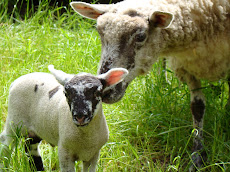I know it's only December and it's freezing outside. I know I'm suppose to be relishing the down time of winter - not lambing, not planting, not harvesting, not canning. But I'm already thinking about next spring and what I want to plant in the garden.
Our garden is huge by many peoples standards, but it's still just a garden. We don't mass produce produce and sell it. We just try to grow enough to feed ourselves well and maybe have enough leftover to share with family and friends. And since we aren't as concerned with high yields as someone who is working the farmers markets we have the luxury of choosing varietals for taste rather than size.

Take for instance the strawberry. If you go to the store, not the farm stand or produce market but a regular chain grocery store, in the early spring you'll find strawberries. Or in reality a form of strawberry is huge, bright red and utterly tasteless. For some reason people loves these. I've been to many friends houses for a meal and they are all excited about the huge, red strawberries that arrived in May. I always smile and eat a few, but I'm think "Seriously?" In June, when strawberries are in season in the Pacific Northwest, there are bunch of varieties of strawberry! They are smaller, sometimes a lot smaller, and range in shades of red. But one of these little cuties packs a flavor punch that completely knocks out the store-bought mega berries. [The picture is of a little mini-strawberry that grows in our flower beds like a ground cover - I have no idea the variety, but they are delicious.]
I recently read an article about a study that looked at the nutrient content of veggies sixty years ago and veggies today. Guess what - not only have veggies been bread for high yields and gigantic size, but they also have been bread in a way that decreases the amount of key nutrients they provide. http://www.grist.org/food/2011-08-02-not-your-grandmas-strawberries. Yesterdays green been was way better for you than today's green bean.
So, here I am thinking about what I want to plant in the spring and I'm thinking I'm going to go with just heirlooms. In the past I have chosen varieties of some things, like butternut squash, that don't take so darn long to ripen. We just don't have the growing season available to wait one hundred days for a squash. Maybe I should honor that and not grow butternut squash. Just a few hours west, in mid-Washington, farmers are growing butternut squash and I can buy those at my corner market.
What I am going to do in my down time is some research. What are the best heirlooms for my region? What can I realistically grown in ninety days? Ninety days is about all we get of good sun and warm temperatures. What will pack the best flavor-punch and hopefully also be full of vitamins and minerals? If anyone out there has some suggestions, I'd love to hear them.













4 comments:
I've gotten several seed catalogs in the mail but I haven't had time to look at them yet. Usually by this time of year I'm anxious to start but for some reason the bug hasn't hit me yet.
I'm curious to hear what you decide on. My family and I are hoping to move to the NW from the Midwest this summer, so I'm going to have to learn an entirely new form of gardening. If you do the homework this upcoming year, I won't have to next when I can get a garden of my own in. :)
@ Mad Typist - Where will you be moving? I've gardened both east and west of the mountain range and the difference is startling. East you can grow corn, west you can't. West, strawberries are amazing, east we barely got any. We live in southwest Washington now.
I'll post my seed order. Last year's order is here already - just search for "seed" and it should come up.
If all goes well, we'll be in or near Seattle by August. And after a lifetime in the midwest, I can live without seeing corn grow. Or soybeans, for that matter.
Post a Comment